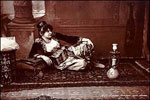
Lost Egypt: Photography
and the Early Documentation of Egyptian Monuments
Within ten months of the official announcement of the invention of photography in 1839, two Frenchmen, Horace Vernet and Frédéric Goupil-Fesquet, began making daguerreotypes in Egypt. Their image of the harem gate of Mehmet Ali at Alexandria is probably the first photograph made in Egypt, and caused a sensation when exhibited in Paris due to its suggestive subject matter. Thus opened a remarkable chapter in the documentation of the monuments of Egyptian civilization.
Early photographic processes were laborious and not at all suited chemically
to the climate of Egypt, requiring unusual dexterity and patience;
all of them had limitations. Daguerreotypes were positive images
on copper plates; publishers issued collections of engravings
and aquatints based on them, but the daguerreotypes themselves
could not be mass reproduced. As a result of his experience with
the daguerreotype in Egypt, for example, one photographically
inclined traveler expressed his relief that several of his friends
were artists. After 1850, most of the photographers working in
Egypt made use of the wet collodion process. Using this method,
the photographer spread collodion evenly over one side of a sheet
of glass, dipped the glass in silver nitrate in order to coat
the surface with photo-sensitive silver salts, hurriedly exposed
the wet plate, and developed and then fixed the glass negative,
hopefully still wet. To this frenetic and closely paced process,
the Egyptian climate often added the horrors of boiling chemicals,
pouring sweat, desiccating heat, and blasting sand. The necessary
materials required a wagon which the photographer dragged with
him everywhere — some of the Egyptians imagined with admiration
that Francis Frith's photographic wagon housed his gorgeous wives,
whom he jealously and watchfully brought with him on all his photographic
excursions. In the 1850s and 1860s, Louis de Clerq used the outmoded
calotype process instead of glass plates, perhaps in the interest
of traveling light.
1
of 4
next
»
|
 |

|
 |


Figure
1, Vol. I: Dame turque sur divan, by Zangaki.
»
| E
X P L O R E |
| The
Further Exploration page has many links to great
sites about Ancient
Egypt. |
|
|
|